The New England Opioid Epidemic | Port in a Storm
Nowhere in America has the opioid epidemic been so deadly as New England. From the beginning, Gloucester, Massachusetts, has been on the front lines of a war seemingly without end.
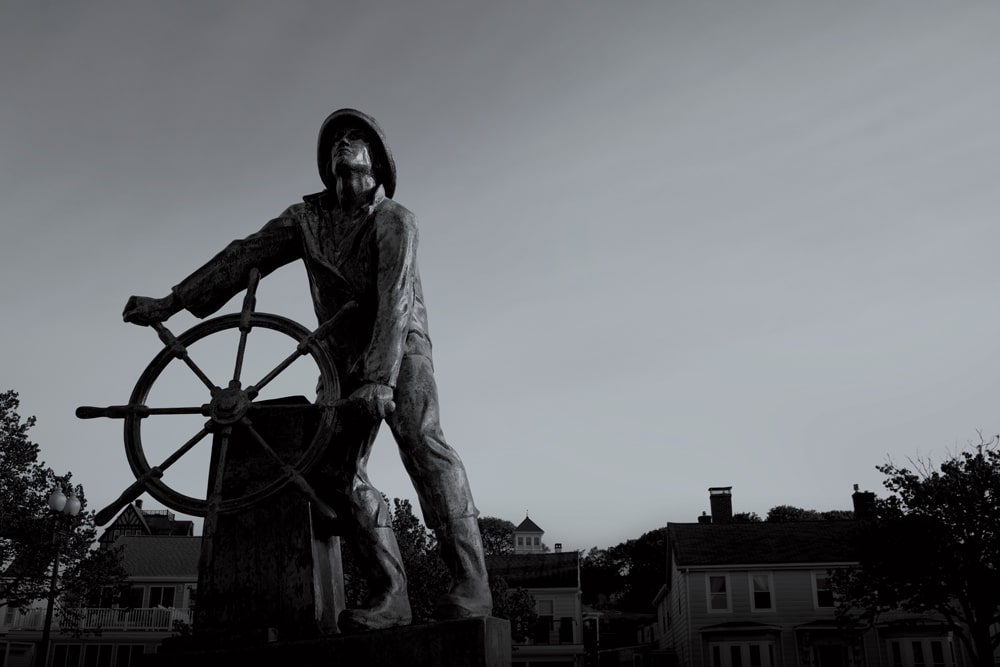
Port in a Storm | The Opioid Epidemic in Gloucester, Massachusetts
Photo Credit : Andrea Bruce / Catchlight Foundation via Pulitzer Center*An asterisk indicates that the name has been changed to protect the individual’s privacy.

Photo Credit : Andrea Bruce / Catchlight Foundation via Pulitzer Center
Early Saturday morning of last year, on Labor Day weekend, Tito Rodriguez picked up his phone and saw an urgent text that snapped him awake. The message was from Sefatia Romeo Theken, the mayor of Gloucester, Massachusetts.
Five overdoses last night, four saved on Narcan, one died! read the text.
Rodriguez, an addiction care advocate in Gloucester, had long feared the possibility of a night like this. Over the past two years, illicit concoctions of fentanyl—a cheaper and more potent opiate than heroin—had hit the streets of his city. Typically, the drug was disguised as or mixed with heroin, and often users simply weren’t sure what they were taking.
For the rest of the morning, the 68-year-old Rodriguez, whose connections in the local addiction community include some 20 people he sponsors in Narcotics Anonymous, remained on his phone, texting and talking with police, city leaders, and worried users. “People were really scared,” Rodriguez said later. “They were worried about their friends and what might happen to them.”
In all, emergency personnel responded to six overdoses, the most Gloucester has ever recorded in a single 24-hour period. The 911 calls included one from a 36-year-old woman who frantically dialed on behalf of her unconscious fiancé. She watched as first responders revived him with Narcan, a drug that reverses the effects of an opioid overdose, then rode with him by ambulance to Addison Gilbert Hospital. It was his second overdose in less than a week. As a medical team examined the man, she slipped into a bathroom, locked the door, and used the couple’s remaining fentanyl. It was at least an hour before her body was discovered.
A few days later, on a muggy Tuesday morning, I met with Rodriguez in downtown Gloucester. Like so many on the front lines of the city’s opioid crisis, he was still trying to make sense of the weekend’s overdoses, including that tragedy at the hospital. “The boyfriend was in bad shape,” he told me. “I’m just speculating, but I think she thought he wasn’t going to make it and decided to take her own life.”
Rodriguez’s insight into the world of addiction is both professional and personal. A Bronx native, he watched his mother struggle with heroin, then picked up the habit himself during an Army tour in Vietnam in the late 1960s. Over the next decade and a half, his wife left him, he lost contact with his oldest son, and, after moving to Boston in 1976, he bounced in and out of homelessness. He got sober in 1982 and embarked on a career in juvenile justice. His specialty: helping people get into recovery. He remarried and now lives in Rockport with his wife and two children, ages 18 and 22.
Two years ago, Rodriguez took a job with the city’s Angel Initiative, a pioneering program founded in 2015 that works with the police department to get people into treatment. The program’s downtown office sits across the street from the PD, in a converted department store building that it shares with a nail salon, a tae kwon do school, and a yoga studio.
On this morning, Rodriguez made the short walk from his office to the Grace Center, a day shelter housed in the basement of a Unitarian church that serves breakfast and lunch to the city’s homeless and low-income residents. In the wake of the fentanyl overdoses, a somber mood hung over the center. As Rodriguez entered, a teary-eyed woman named Georgia* approached him. A pair of sunglasses was perched atop her long brown hair, which fell past her shoulders, and a set of small green hearts were pinned to her ears.
Rodriguez put his hands on her shoulders. “You doin’ all right?”
Georgia nodded and blinked hard.
“You know it’s not you,” Rodriguez said. “You’ve got to remember that.”
She cleared her throat and looked down at the ground, then back at him. “They were my friends,” she said. She started to cry and leaned closer to Rodriguez. “Every time I turn around….” Her voice trailed off.
“But it’s not you,” Rodriguez said.
“I know,” she said, exhaling deeply. “I’m not that stupid. Not that it’s stupid. But too many of my friends are going.”
“You tell them to come see me,” Rodriguez said.
“OK, I will,” Georgia said. She gave him a hug and returned to her lunch.
About 20 minutes later, Rodriguez and some volunteers tried to rally those at the center, maybe 30 in all, to come together to talk about what had happened over the weekend. But nobody was ready to do so. Several headed outside for a smoke. Others restlessly picked at their chicken and broccoli. The emotions were still too raw.
———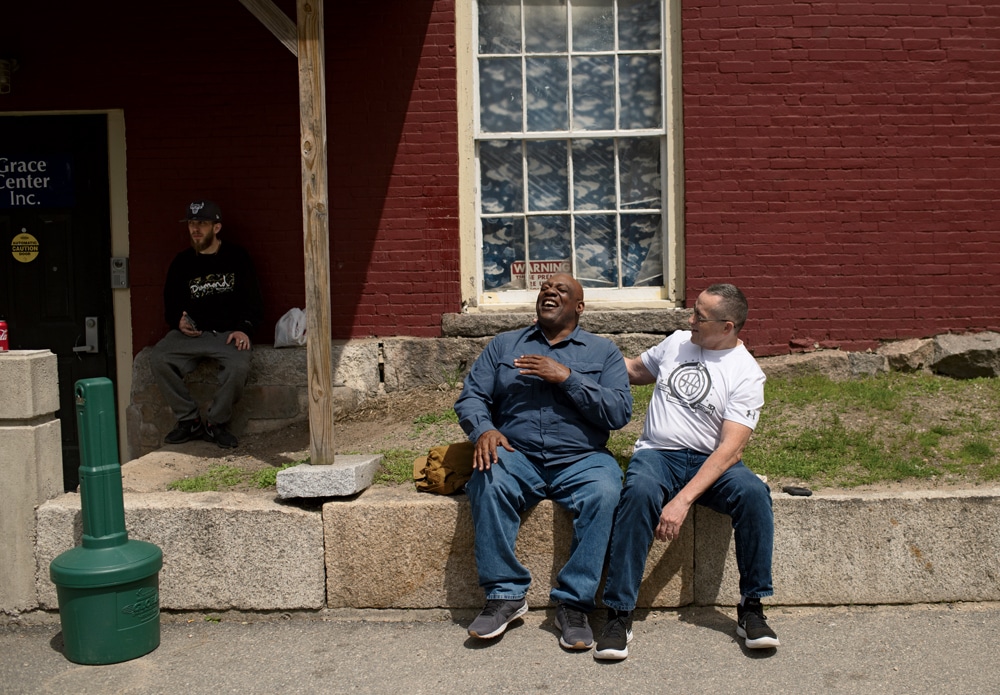
Photo Credit : Andrea Bruce / Catchlight Foundation via Pulitzer Center
Gloucester flourished deep into the 20th century. In 1925, local resident Clarence Birdseye perfected food freezing, allowing fresh Gloucester cod and haddock to reach dinner tables throughout the country. By the 1970s, a day’s catch might bring more than a million pounds of fish landed to the city’s wharves. The harbor buzzed with action—offloading, processing, cutting, cooking, freezing—from 4:30 a.m. to late at night. Locals joked: Manchester by the Sea, Gloucester by the Smell.
But when fish stocks declined, the federal government imposed an evolving set of controversial restrictions and quotas. In 2013, when a new round of catch limits was implemented, just 70 commercial groundfishing boats operated out of Gloucester. Today, the number is a third of that.
Gloucester has fared better than some other New England communities that have lost much or all of their core industry. The city is still home to several large food-freezing plants, its three industrial parks remain nearly full, and increasingly the harbor has become home to expensive pleasure boats. Just two years ago, a 94-room boutique hotel overlooking the harbor opened its doors. Beyond the water, a Main Street facelift has pushed out the tough bars that police once responded to nearly every night. As its fishing identity has waned, Gloucester has become a place that generally attracts more fortunes than it makes.

Photo Credit : Andrea Bruce / Catchlight Foundation via Pulitzer Center
And yet drugs have long found a kind of traction in Gloucester that they haven’t elsewhere. Since the 1960s, heroin has plagued pockets of the community—so much so that The New York Times took note in 1988 with an article headlined “Massachusetts Port City Fighting Heroin Problem.” At the time, police were responding to around six overdose deaths per year, “far more often than in other Massachusetts cities of similar size,” the Times observed.
This recent history combined with Gloucester’s identity as a fishing port may explain both the city’s current opioid problem and its resiliency in dealing with it, says Tony Gross, a Gloucester native and longtime fisherman.
“We went out in little boats and built lives out of something very unpredictable,” he told me. “There were no guarantees, and I think that allowed us to handle the unexpected, to handle adversity. But it built in us the desire to take risks.
“People used to say the reason heroin was an issue here was because it was shipped in from Afghanistan or wherever,” he continued. “That’s not what contributed to it. We didn’t have some pipeline—there was simply demand for it.”
———Not since the AIDS epidemic in the early 1980s has theUnited States been gripped by such an intractable health crisis. More than 2.5 million Americans are addicted to opioids. Since 1999, some 200,000 have died from overdoses related to prescription opioids, and it is estimated that all opioids will claim the lives of half a million citizens in the next decade.
“It’s not like any other kind of addiction,” Rodriguez told me. “To this day, when I smell the sulfur from a lit match, or even just say the word heroin, my taste buds start to churn. Even now.”
New England has been hit especially hard by the crisis. According to a recent Centers for Disease Control report, in 2016 only Vermont had an overdose death rate statistically similar to the national average (19.8 per 100,000). The region’s other five states came in higher, and New Hampshire (39 per 100,000) was surpassed by only West Virginia and Ohio. Last year the Granite State’s chief medical examiner, Dr. Thomas A. Andrew, no longer content to merely catalog the crisis, retired to enter seminary school so that he could approach the problem in a new way: by ministering to young people. “It’s almost as if the Visigoths are at the gates, and the gates are starting to crumble,” he told The New York Times. “I’m not an alarmist by nature, but this is not overhyped. It has completely overwhelmed us.”
No place has been spared. In Maine, opioids have driven a surge of drug-related fatalities, from 34 in 1996 to 418 in 2017. Rhode Island’s governor, Gina Raimondo, called the epidemic the “single greatest public health crisis of our time.” Fentanyl is now the leading cause of fatal opioid overdoses in Massachusetts, which is behind only New Hampshire and West Virginia in per-capita deaths from the drug.
But death rates tell only part of the story of how opioids have affected communities. Gloucester fishing boat captains struggle to find deckhands who aren’t battling addiction, while more and more residents here are seeking training in how to administer Narcan, in case they are called upon to save the life of a loved one or even a stranger. As the situation has worsened, it’s put a strain on budgets, social services, and, sometimes, even the compassion required from those on the front lines.
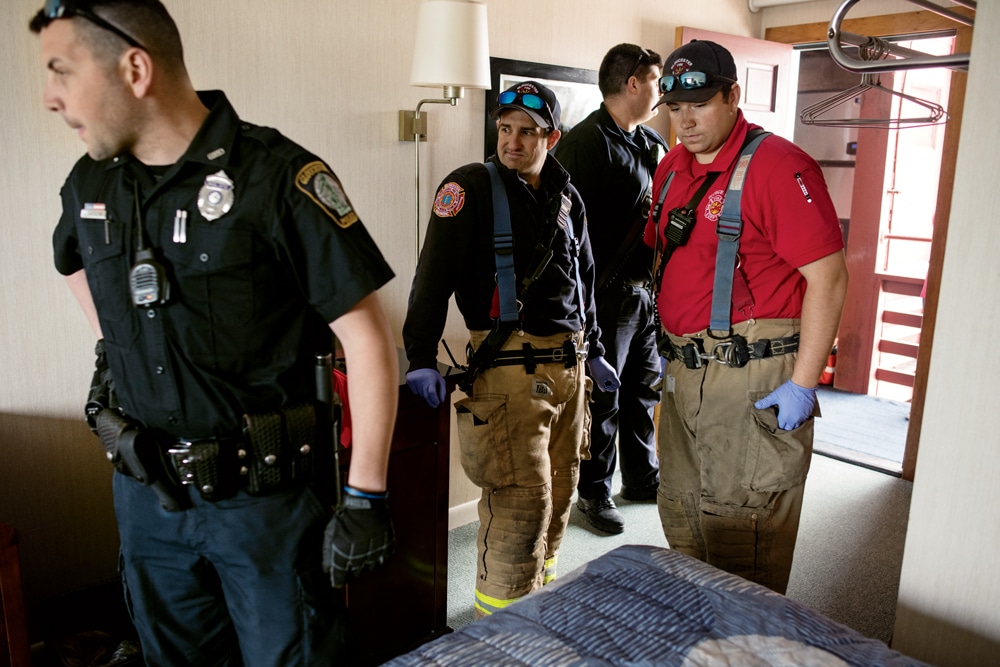
Photo Credit : Andrea Bruce / Catchlight Foundation via Pulitzer Center
“When it’s 2 a.m. and you have to help somebody to the hospital, and maybe you’ve already helped them three or four times that month, or maybe even earlier that day, it beats you up. You’re dealing with pretty traumatizing work,” Sandy Schultz, Gloucester’s longtime emergency medical services coordinator, told me shortly before he resigned his position last summer to go “back online” as a firefighter paramedic. “Then there are the domestic issues. Maybe they have kids, or maybe they overdosed in front of those kids. [For some first responders] it’s possible these issues have surfaced in their own families. You can get crispy.”
I had come to Gloucester, however, not just because its storyline tracked with what was happening elsewhere, but also because it’s proven innovative in dealing with the opioid crisis in ways that many cities have not. In 1989, Gloucester opened the doors to Massachusetts’s first state-funded methadone clinic, and later the city used state and federal dollars to expand social services and make Narcan more widely available. In 2011, Gloucester became the first municipality in Massachusetts to equip all police, firefighters, and other first responders with Narcan. Six years later, all city buildings were equipped with it, too.
Then, in early May 2015, Gloucester essentially called for an end to the war on drugs. The first four months of the year had been gut-wrenching: four fatal overdoses, more than in all of 2014. A public forum brought together the health department, the city council, the mayor’s office, and police leaders to rethink how the city approached addiction.

Photo Credit : Andrea Bruce / Catchlight Foundation via Pulitzer Center
Within hours of the forum, the police chief at the time, Leonard Campanello, announced a stunning policy change on Facebook. “Any addict who walks into the police station with the remainder of their drug equipment (needles, etc.) or drugs and asks for help will NOT be charged,” he wrote in a post that would be viewed by more than 2.4 million people over the next month. “Instead we will walk them through the system toward detox and recovery” and place them in treatment “on the spot.”
The Angel Initiative launched the following month, and its immediate success put a spotlight on the need to increase access to treatment. Within its first six months, Angel placed 391 people into recovery. Today it works under the Gloucester-based Police-Assisted Addiction and Recovery Initiative (PAARI), which builds and supports Angel programs across the country. To date, the Gloucester approach has been implemented at 414 police departments across 32 states, from the Northeast to the deep South.
“Your mind-set, being a policeman, was always to arrest for drugs,” current police chief John McCarthy, a Gloucester native who joined the force in 1980 at age 21, told me. “I’m old-school, and that was always the philosophy. [But as Chief Campanello would say] ‘you can’t arrest yourself out of this problem.’ We fought the war on drugs for decades and decades and didn’t win.”
———One day last December, I met up with LieutenantJeremiah Nicastro at the PD’s downtown headquarters. Hailing from a long line of Gloucester fishermen, Nicastro, 43, knew even as a young boy that he didn’t want to follow his father and grandfather out to sea. “You could see the writing on the wall,” he said. “All these fathers under so much stress, just struggling financially.” Hooked by the TV cop shows he watched growing up and by a desire to make a difference in his community, he went into police work.
As the face of his department’s Angel program, Nicastro works closely with Rodriguez to follow up with residents to whom emergency personnel had recently responded for an overdose. There were two visits scheduled for this morning.
As Nicastro waited for Rodriguez, he sat at a conference table and banged away at his phone. On the other end of his texts was a relative whose 30-year-old son, John*, had barricaded himself in a shack on a friend’s property and was presumed to be using fentanyl with a buddy. The young man’s addiction issues had been discovered five years ago when Nicastro arrested a Percocet dealer: When searching through the dealer’s phone, Nicastro found a text from John that said he was willing to sell 100 pills.
“I couldn’t believe it,” he said. “[John] said he was just doing it for a friend. But then he admitted he was using the pills and worked with a dealer in Beverly. Later I found out he was doing heroin, and I had to tell his father about that.”
Nicastro showed me a photo of John that had been taken during a stretch of sobriety. “Here we are five years later, and he’s hooked on fentanyl.”
After years of failed treatment programs, Nicastro was now trying to get John’s father to agree to seek involuntary court-ordered treatment for his son. “I’m just afraid of the phone call we’re going to get if he overdoses,” he said.
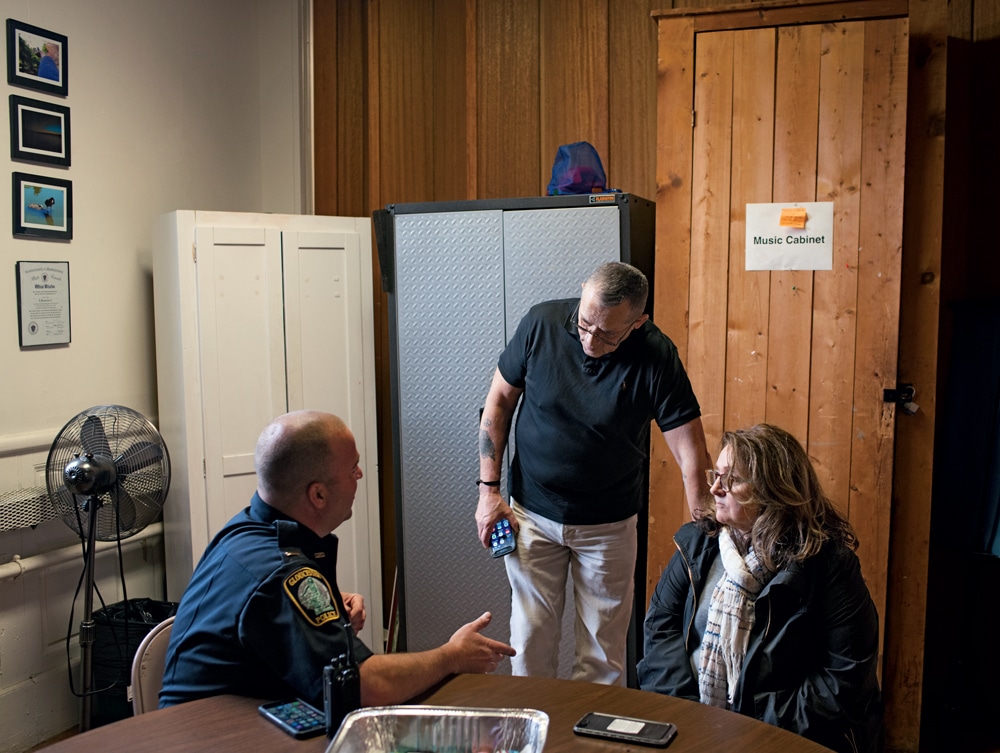
Photo Credit : Andrea Bruce / Catchlight Foundation via Pulitzer Center
Rodriguez appeared, wearing a Rockport Basketball warm-up jacket and toting a purple bag filled with Narcan kits and a notebook he uses to log phone numbers and observations from the visits. Soon, we were making our way along narrow downtown streets in a large black pickup. Remnants of the season’s first snow clung to lawns.
First stop was a third-floor apartment in a three-family home across the street from a house that Nicastro’s family once owned. Its tenant, Sean*, was in his early 20s with unruly brown hair, a patchwork beard, and thick black-framed glasses. His skinny frame was draped in baggy sweatpants and a green sweatshirt with “Southie” across the front. He led us to his living room, where a few Santa figurines and some holiday cards were displayed on a table. On a wall was a plaque that read: Home is where my dog is. The room smelled of cigarettes. A cat circled Nicastro’s feet. Sean took a seat on a couch, and Rodriguez joined him.
“You from Southie?” Rodriguez asked.
“Nah, it’s just a sweatshirt. I’m from outside of Boston.”
While Nicastro stood quietly off to the side, Rodriguez tried to gain a portrait of Sean’s life. Where did he work? Whom did he live with? How long had he lived in Gloucester? Then: “You mind if I ask about the event?”
“I thought what I had was a Xanax bar,” Sean said, running his hands through his hair. “I crushed it and sniffed it. I guess I just [passed] out.”
“Was it Xanax or fentanyl?” Nicastro asked.
“It was definitely fentanyl,” Sean said. “It wouldn’t have worked on me if it was just Xanax. That’s the thing that freaked me out the most.” He added, “My [buddy] just died today from that in Vermont.”
The three men were silent for a moment before Rodriguez spoke again. “Is Xanax your drug of choice?”
“No,” said Sean. “I smoke a lot of weed but I just take Xanax because I have wicked bad anxiety. And wicked bad ADHD. Like, through the roof.”
Rodriguez asked if he needed to go into detox. Sean laughed. “No, I’m good.”
“If you ever need help, you can come to the police department,” said Nicastro. “And if you’re not comfortable coming to us, you can go across the street to PAARI. We’ve done more than 600 of these. We won’t judge you. There’s no stigma. We’re going to treat you like one of ours.”
Rodriguez then asked if Sean needed any Narcan. Sean waved him off. “It was really just one Xanax bar,” he said. “That’s why my mind was blown.”
A few minutes later, Sean walked his guests to the door and shook their hands.
“You let us know if you need anything, OK?” said Nicastro. “Have a good holiday. Watch what you buy.”
Back in the truck, Nicastro gripped the wheel and looked at Rodriguez. “That’s scary,” he said.
“The Xanax?”
“Yeah. But I do believe him.”
“He would have taken the Narcan otherwise.”
“Yeah, that was my thought right away.”
“I don’t think he’s a regular user,” Rodriguez said. “But what’s good is that if he knows somebody who is using, he might be able to tell them about us and get them help.”
———There’s a difference in how civic leaders are discussing and approaching this crisis compared with past drug epidemics. There’s less blaming of moral shortcomings, and more talk of addiction as a disease. Something that needs to be treated rather than penalized.
Why the shift? It’s partly the result of time and experience, of seeing the many failures of the war on drugs. But race also plays a role. The truth is, the opioid crisis cuts across every ethnic and socioeconomic group. There can be no “othering” it away, as with inner-city heroin use in the 1970s or the crack epidemic a decade later. In 2016, white users accounted for nearly 80 percent of fatal opioid overdoses in the U.S. The increased volume of media coverage and talk of policy change can be attributed to the fact that now the users look a lot more like the journalists and politicians who frame how this issue is discussed and managed.
“This is just my opinion, but if this was really just happening with African-Americans or Hispanics, I don’t think we’d see the kind of response we’re seeing now,” Rodriguez said. “But the important thing is: People are getting help.”
After leaving Sean, we drove to North Gloucester and pulled up in front of a new duplex. It had a farmer’s porch with views of a saltwater marsh; neatly manicured small trees framed the lawn. Several days earlier, emergency personnel had responded here to administer Narcan to a middle-aged man, Jeff*, who had collapsed inside the house.
After several rounds of knocking, a woman in her mid-20s opened the door to greet Nicastro and Rodriguez. Her name was Sarah*.
“Sorry,” she said with a laugh. “I was sleeping.”
Nicastro smiled. “Is Jeff your dad?”
She nodded. “He’s at work.”
“Do you have a phone number?” Nicastro said. “We just want to reach out to him.”
“Hold on, he just got a new number. I’ll go get it.”
After she left, Nicastro turned to Rodriguez with a concerned look. “I’m not sure she knows,” he whispered.
When Sarah returned, Nicastro asked if she had been home the previous Friday.
“I was.”
“So you know what happened, right?”
“I do.”
Sarah seemed unfazed by the questions, as though Nicastro was asking her for directions. After he explained the purpose of the visit, she invited us inside. In the kitchen, Rodriguez taught Sarah how to use Narcan. As she fiddled with the nasal spray, Nicastro gently pressed for more details about her dad. “Did he relapse?” he asked.
Sarah shrugged. “I’m not sure. [My parents] don’t tell us much. They tried to hide it for a while.”
“Would he be upset that we talked to you?”
“I don’t think so. But honestly, I don’t care if he was mad.”
Nicastro’s eyes fell on a family portrait hanging over the kitchen table. “I know your mother,” he exclaimed. “She worked at the drugstore.” He looked again at the photo and smiled. “She knows who I am. She won’t be mad that we talked.”
A few minutes later, Nicastro and Rodriguez headed to the door. Rodriguez left Sarah with one of his cards. “You let us know if you need anything,” he said.
———
Photo Credit : Andrea Bruce / Catchlight Foundation via Pulitzer Center
The current illicit drug crisis is really a morevirulent strain of several older ones.
At the time of the American Revolution, various forms of opium had found a foothold in the colonies as a medical tool. By the middle of the 19th century, Americans were treating everything from teething pain to menstrual cramps with medicines whose lead ingredient was opioids.
But it was the Civil War that ushered in the country’s first significant drug crisis. With the advent of the opium-derived painkiller morphine, doctors were able to make battlefield injuries more tolerable. Addiction rates soared among veterans, and this “soldier’s disease” soon spread to the wider population. By 1870, opium was more available in the U.S. than tobacco would be a century later.
In 1898, a new “addiction-free” cough syrup called heroin was introduced to remedy the morphine problem. But even as understanding of this new drug came into focus and laws tightened, U.S. addiction rates soared at different times, among different populations, during the 20th century—no more so than in the ’60s and ’70s, as soldiers like Tito Rodriguez returned from Vietnam dependent on the drug.
Nearly a century after heroin’s introduction, its cycle— from a sanctioned medicine to a popular street drug—was repeated on a much larger scale. In 1996, Connecticut-based Purdue Pharma debuted OxyContin, which it touted as a safer kind of opiate pain reliever. The new medication featured oxycodone, typically used with terminal cancer patients, in a formula that slowly released the drug into the digestive system.
Now a new era in pain management began, as more pharmaceutical companies starting bringing other oxycodone-based medications to the market. Between 1996 and 2002, Purdue funded more than 20,000 pain-related educational programs and pushed its lobbying dollars to groups like the American Pain Society to help doctors overcome what it dubbed “opiophobia.”
“If you could go back in time, to the early ’90s, you’d find that textbooks would say, ‘Don’t give opioids, don’t treat back pain with narcotics,’” said Dr. Andrew Kolodny, codirector of opioid policy research at Brandeis University’s Heller School for Social Policy and Management. “If you were to talk about this with doctors then, they would tell you they’re worried about their patients getting addicted. That the doses would have to get higher and higher to get pain relief. [The pharmaceutical campaign] reframed these very good reasons for being cautious with opioids as barriers to compassionate pain care. You started hearing that the fears of opioids are unrealistic or irrational and can lead to suffering. I think the emotion of the medical community was: We’ve been letting people suffer, and I’m going be different. I’m going to understand that opioids are a gift from Mother Nature and that real addiction is very rare. I’m going to be a good doctor and not like those stingy, puritanical doctors from the past. That was the feeling. And once that sunk in, it became very difficult to unlearn.”
Purdue touted its star drug as being nearly addiction-proof—but it wasn’t. Users realized the pills could be crushed into powder to be injected or snorted. Abuse of OxyContin and competitors like Vicodin and Percocet became rampant.
Eventually, the evidence and the hammer of the federal government forced Purdue to accept some responsibility for the crisis. In 2007, after making billions in profit, the company agreed to pay $634.5 million in fines to resolve criminal charges of “misbranding.” A portion of the money was then directed to states to help fund prevention programs.
In 2010—the same year that prescription opioids accounted for 43 percent of all overdose deaths in the U.S.—Purdue released a reformulated capsule that is harder to crush. The easy flow of doctor-prescribed pain meds also began to tighten. From 2011 to 2017, opioid prescriptions fell in the U.S. by 29 percent.
But those changes came too late for a population of addicted Americans who scrambled to meet the increasing street price of oxycodone. Opportunistic drug cartels flooded many communities with cheap heroin. The switch from pills became easy and economical. Today, a single pill of Percocet goes for $30 on the street. Some users will require eight to ten capsules a day. An equivalently potent amount of fentanyl can be picked up for $50. “Every single person I’ve interviewed who was hooked on heroin [or fentanyl] started with Percocets or OxyContin,” Nicastro said.
———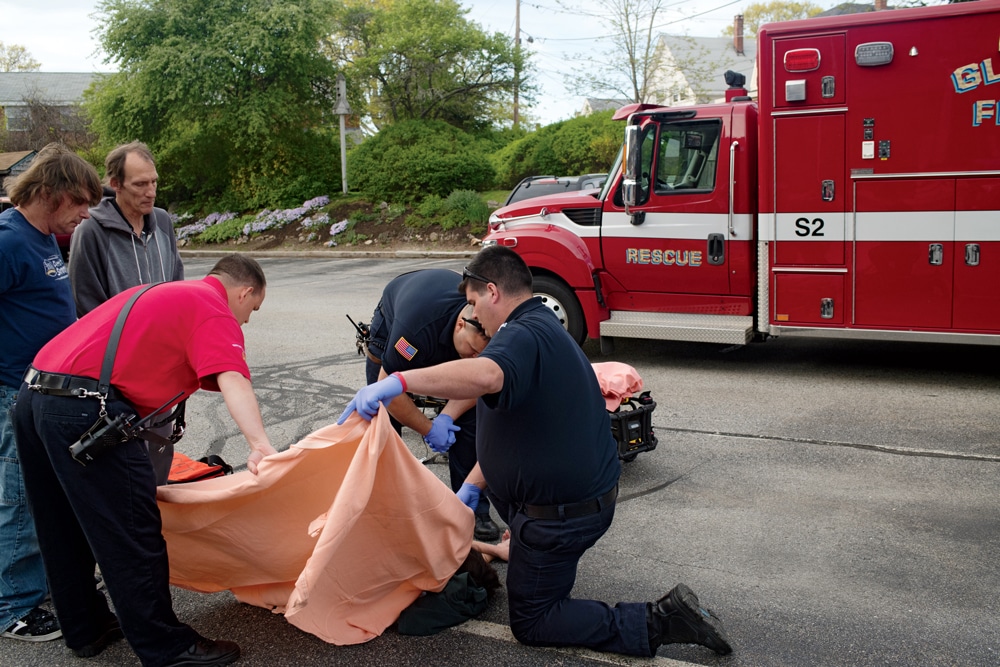
Photo Credit : Andrea Bruce / Catchlight Foundation via Pulitzer Center
As Narcan has become cheaper and easier to administer in recent years, trainings on how to use it have become more frequent in Gloucester. They’re a mix of larger, formal gatherings—PAARI has hosted several for fishermen’s groups along the North Shore—and smaller, looser sessions. One November afternoon I attended one of the latter kinds of meetings, held at the Grace Center.
The session was headed by Angela Mae Burnham of OneStop Harm Reduction, a small agency that offers counseling, disease screening, and Narcan distribution and education, as well as access to a needle exchange program. Gloucester roots run deep with Burnham, who is 26 with a slight build and a preference for attire that leans heavily punk. The local middle school is named after her great-grandfather, and the statue at the center of the city’s annual Saint Peter’s Fiesta was donated by her family.
Burnham brings to her work a surprisingly deep understanding of synthetic drugs that calls back to a childhood obsession with chemistry. She also brings an appreciation of the drug user’s mind-set: She has an app that shows to the second the time since she herself last took heroin. “I stopped doing dope on July 1, 2015,” she told me proudly, displaying her phone.
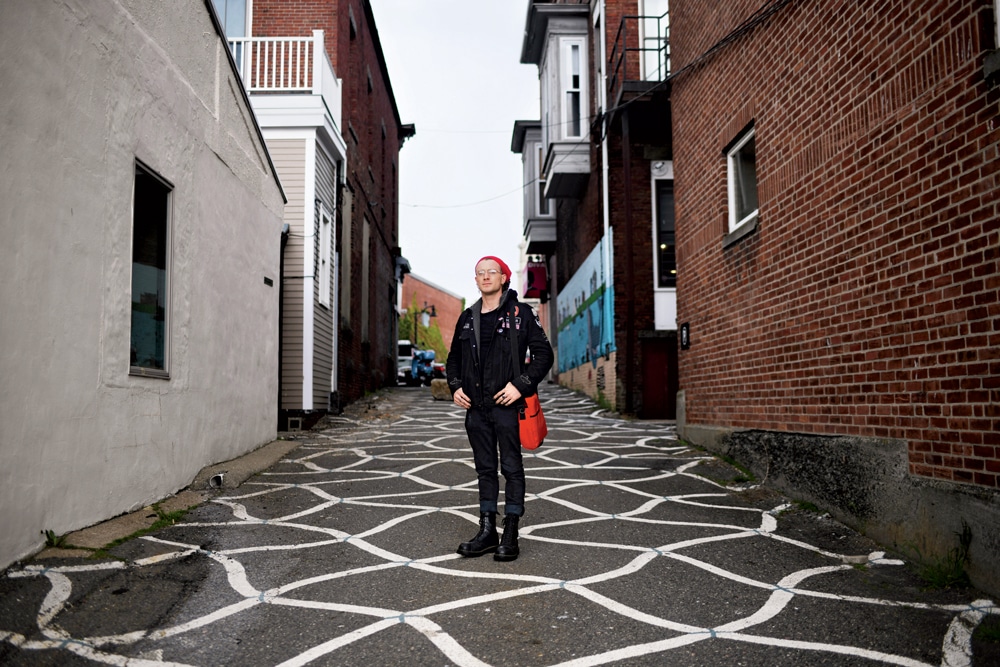
Photo Credit : Andrea Bruce / Catchlight Foundation via Pulitzer Center
As Burnham unpacked the Narcan kits for the session, a young man named David* rushed to take a seat. “I’m here for my brother,” he announced. “He’s coming back to Gloucester soon, and I want to keep him safe.”
A few others followed him: a middle-aged woman, Elizabeth*; a man about the same age, Jim*; and a homeless couple, Sam* and Darlene*, who had recently left their camp in the woods for a hotel room. As Burnham finished her setup, David glanced at his phone.
“I gotta go,” he said, getting up quickly. “Just got a message from my buddy. Sorry.”
Shrugging off David’s departure, Burnham started the session with a question: “Anyone here experienced with an overdose?”
Everyone was.
“I overdosed two weeks ago, and she saved my life with Narcan,” Sam said, looking at Darlene, who stared at the ground.
“What are some of the reasons we do opioids?” Burnham asked.
“Boredom,” said Jim.
“Not to feel your pain,” said Elizabeth. “You want to forget for a while.”
Burnham’s gaze turned toward Sam. “Honestly, you wanna know why I get high?” Sam said. “So I don’t have to feel the feelings for life.”
“It’s all of that,” said Burnham. “When we talk about this stuff, we have to be really mindful of the fact that we’re not consuming this for no reason. Nobody ever woke up and shot up [drugs] for no apparent reason.”
At the Grace Center, these Narcan training sessions can take different forms. Sometimes Burnham does most of the talking, as she demonstrates how to effectively use the drug. But other meetings turn toward talking about the vicious grip of addiction. More therapy than information sharing. When that happens, Burnham adjusts.
“Two weeks ago, I did fentanyl,” said Sam. “I thought it was heroin. I did a shot, then did another shot. Then I don’t know what happened. I woke up and [Darlene] was crying. What’s going on? I asked her. I just Narcaned you, she said. You were friggin’ dead.”
He turned back to Burnham. “Here’s what scares me. We’re in the woods. If I died there, she’d have to go get a cop and bring him into the woods and find me dead. For three hours I was walking around, thinking about it. Was this really worth it? I go to the Suboxone clinic, and I won’t lie: Most of the time, I sell those things. And here’s why. Suboxone keeps you from getting sick and all that other shit, but the feelings I have of life right now, I just don’t want to feel them because it destroys me. I have so many responsibilities right now. Like getting my kids back. I’ll act like a tough guy and pretend it doesn’t matter, but I’ll break down and cry. And I don’t want to feel that.”
“You’re better off crying,” Elizabeth said, finally.
“I’m sorry, guys,” Sam said, looking around the room. “Honestly, I haven’t talked to people like this for a long time. I just want it to be done.”
Burnham steered the conversation forward. She touched on what puts people at risk for an overdose and how to identify if someone needs resuscitation or is simply in a deep high.
“Let’s get into Narcan,” she said, pointing to the kits. “It’s an opiate receptor antagonist. It goes and knocks the opiate off the receptor and sits on top of that receptor.” She made a fist, then covered it with the open palm of her other hand. “It will stay there from five to 90 minutes and tell the body to start breathing again.
“But what you’ve got to be cautious of,” she added, “is that when the person comes to they’re going to be very confused. They may not know where they are or what happened. You need to be patient and calm. For them it’s like being in a cozy bed, with a warm blanket. Now you’ve come and ripped that blanket off and thrown cold water on them. I’ve known people who’ve come out swinging.”
The Narcan training centered on the nasal spray canisters that users empty into each nostril. When Burnham held one up, Elizabeth laughed. “It goes in your nose? I thought it went into your chest. I don’t know what I was thinking.”
“You’re thinking of the movie Pulp Fiction,” Burnham said, smiling.
Jim, who had stayed mostly quiet, spoke up. “I wish I’d been with my friend and had some of this,” he said. “But I wasn’t. I think he was alone in his apartment.”
Burnham looked at him. “Mine was, too. Best friend. Last year.”
A brief silence fell before Burnham spoke again. She assured the group that Narcan can be picked up without a prescription at most drugstores and then emphasized that it’s allowed in the homeless shelter. “I can enroll everyone today and get you Narcan,” she said, wrapping up the session.
“But first,” she said, raising a finger in the air, “I need a smoke.”
Outside, Darlene and Sam sorted through what was swirling in their heads. They were speaking to everyone, themselves, or maybe nobody in particular. “The truth is, if I keep using, I’m gonna die,” Sam said. “I know that.”
Darlene shuffled her feet and took a few drags on her cigarette. “We’re looking for an apartment, but our best option is going into a program,” she said. “I can get a place, but that’s not going to stop all those feelings and emotions. I’ll have to go through the courts to get my kids back and it’s going to be emotional and it’s going to tear me apart. I’ve got all these emotions from the past. I’m going to continue to use, and using is going to affect me.”
She looked at Sam. “I know we can get clean at some point,” she said, her voice tight. “It’s gotta stop at some point.”
———In August 2011, a group of Gloucester-area families who had lost loved ones to addiction began an annual tradition. In the shadow of the Fisherman’s Memorial, which honors the Gloucester men and vessels lost to the sea, they gathered to pay homage to another population that’s passed. They made luminarias to line the walkway between the sea and Stacy Boulevard, they sang, and, as the sun dipped below the horizon, they read aloud the names of the dead.
Like the crisis itself, the Overdose Vigil has grown every year; last year 300 people turned out. Old and new lanterns flickered with life, each one inscribed with personalized messages such as For all the women who didn’t make it to recovery and I will always love you.
For years, Gordon and Colleen Bullard were fixtures at the vigil. But last summer was too emotional for them to attend. Just three days before the vigil, the Bullards, who live just over the city line in Rockport, had buried their 30-year-old son, Cory.
I met Gordon, an environmental scientist, and Colleen, an activity coordinator at a Gloucester adult day center, a few weeks before Christmas at their four-bedroom Cape on a quiet tree-lined street. The home, where they raised Cory and his two younger siblings, was decorated for the season. A tree draped with white lights stood in the corner of the living room, Santa figurines lined the stairs, and a collection of miniature holiday trees adorned a side table.
Framed pictures of Cory hung on the walls, and the Bullards moved between past and present tense when they spoke of him. As they talked, Colleen fiddled with a heart-shaped silver charm that hung from her right wrist that read, Always in our hearts. On the same hand she wore a ring that contained a bit of her son’s ashes.
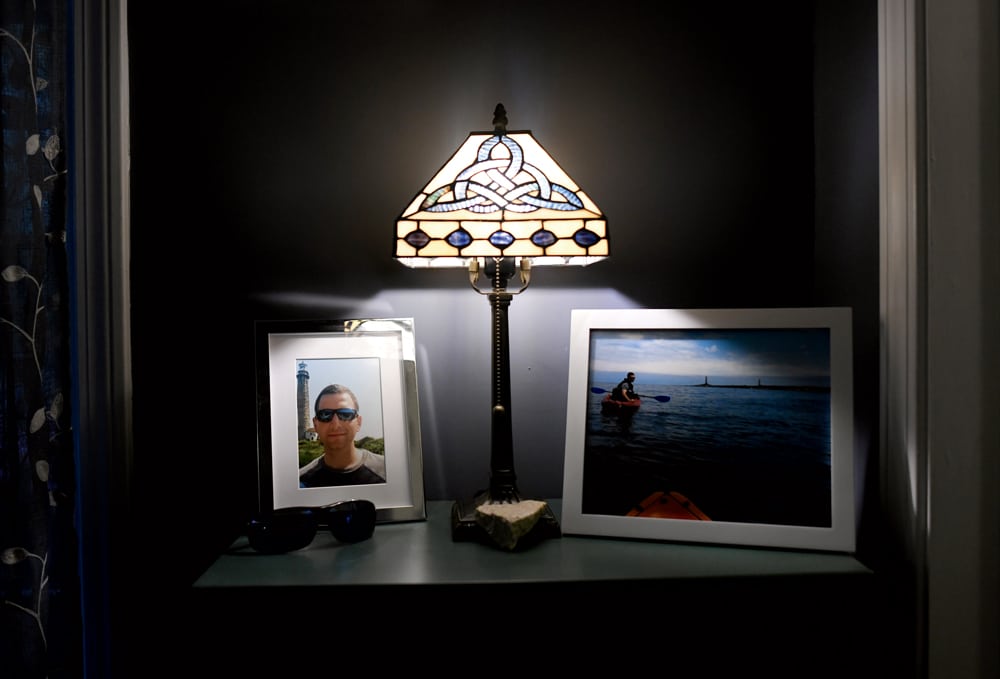
Photo Credit : Andrea Bruce / Catchlight Foundation via Pulitzer Center
At St. John’s Prep in Danvers, Massachusetts, Cory had played football and was an honor roll student. But the years that followed his 2005 graduation were difficult ones. College came in fits and starts. “He had a hard time figuring what he wanted to do,” said Gordon.
In fall 2011, Cory enrolled at the University of Southern Maine in Portland to resume a political science degree he had cut short four years before at James Madison University. He found an apartment in the city, moved in with his girlfriend, and settled into becoming a full-time student again.
A few years before he started at USM, Cory had begun taking medication for anxiety, which he had suffered from for much of his life. At its worst, it brought on unexpected and unexplained panic attacks. But one of the prescription’s rare side effects was seizures.
In October 2012, Cory suffered a seizure at his apartment that induced such severe spasms that he fractured five vertebrae. He was prescribed 90 days of OxyContin. The meds helped his pain, but when he finished, the Bullards noticed he still wanted more. By then Cory had broken up with his girlfriend, left college, and returned home.
Cory’s struggles with addiction weren’t as destructive as they were for other families. He didn’t steal to pay for a hidden habit, or isolate himself from his parents. He didn’t resist going into treatment, and at his lowest point he had asked for a longer-term stay. But the ups and downs, the fears of what might come next, plunged the family into the world of opioid addiction. Gordon learned to use Narcan, and the Bullards attended regular meetings of others, mainly parents, who had loved ones dealing with the same issues.
Their life became framed by Cory’s. Even stretches of sobriety were sometimes clouded by angst. Would it last? the they wondered. And if not, what would the ending look like?
Cory’s death came after he’d finished a long treatment program and completed course and clinical work to become a substance-abuse counselor. A little more than 24 hours before he was slated to begin a new job with a company in South Weymouth, paramedics were called to Cory’s apartment, where they found him unresponsive.
Gordon got the call from the hospital during an early-morning walk with his two dogs.
“I’m thinking he had a car accident … or maybe it’s something about his bad back,” Gordon recalled. “And I’m told, no, when he came in he wasn’t breathing, they were doing CPR on him, and he had alcohol and fentanyl in his system, and it was an overdose.”
Gordon said he could barely register what the doctor was saying. “He keeps talking, and I finally said, ‘Wait a minute, what did you just say? You mentioned something about an overdose?’ He’s like, ‘Oh, I’m sorry, you didn’t know?’”
Gordon’s eyes welled up, and he paused for a moment. “It was out of nowhere.”
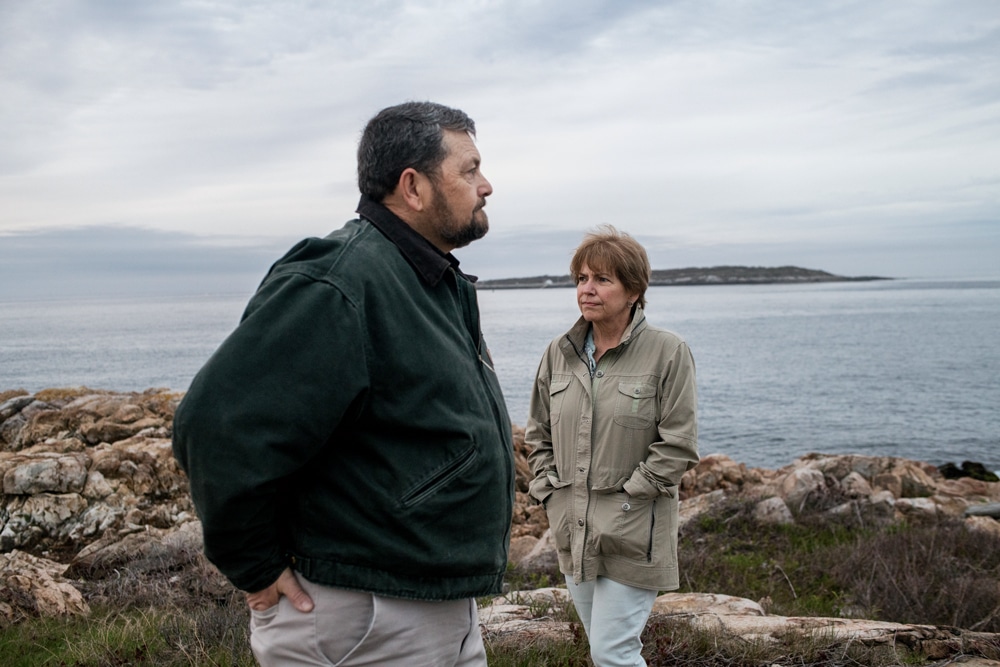
Photo Credit : Andrea Bruce / Catchlight Foundation via Pulitzer Center
The Bullards are navigating their new life by not ignoring their old one. Within days of her son’s death, Colleen knew she had to find something to do that honored who Cory was and what he wanted to do with his life. A few weeks after I visited them, the Bullards announced the creation of the CCB Foundation, a charitable organization that provides financial support to small treatment and recovery programs. They’ve also organized a support group for families who’ve lost loved ones to addiction. They lead the monthly meetings, and sometimes as many as 18 people show up.
“It can feel like a second full-time job, but if I wasn’t doing this, [Cory’s death] would be a lot harder for us,” Colleen told me. “In the beginning, you go through a lot of firsts— the first birthday without him, the first holidays—and you get through those, and then you’re left with a new normal. It never gets easier, but that’s just what it is: a new normal.”
———In May, I spoke again with Tito Rodriguez by phone. It had been a bruising time for Gloucester. Since January there had been seven fatal overdoses. Two had died just the week before, and Rodriguez knew them well. One was a man he’d helped on and off for the past 20 years. The man had had his struggles, but he’d found steady work and seemingly embraced being sober. Then Rodriguez received a text from the Gloucester police that his friend had passed.
“I thought, Man, not him,” Rodriguez said. “But all it takes is one bad thought. One bad decision. As I’ve told people, that could have been me. You can be living sober for a long time, but then you get this idea that maybe it’s OK to just do it this one time. That it will be OK. You can handle it.”
As we spoke, I heard a kind of fatigue and frustration in Rodriguez’s voice I hadn’t heard before. I said as much to him, and he didn’t disagree. “Other people have said the same thing,” he said. For a guy who reminds himself every day of his own past battles with addiction, it had made his own self-care especially important. “I’m going to my meetings, going to the gym, doing stuff that makes me feel good.”
It was a reminder of just how emotionally taxing this work is, of how you have to struggle to balance successes and setbacks. To show up every day as Rodriguez does demands a hardheaded confidence in the power of small victories. I asked him if, at this moment, he was optimistic that society would one day prevail against this implacable illness.
“I am,” he said. “I just have to remember not to personalize it. A lot of people are doing a lot of good stuff. People and agencies are collaborating now in ways they didn’t before. But you have those stretches where the shit hits the fan. There’s been stuff going on with the guys I’m sponsoring and what’s been happening in Gloucester, and it gets to a point where I look at my phone and think, I don’t want to answer this.”
After we hung up, I wondered if he would be OK. And then, 10 minutes later, he phoned me back. There was a sudden spark in his voice.
“I have good news,” he said. “It’s Courtney. I talked to her last week and she’s doing really well.”
Courtney was a 21-year-old woman whom I’d watched Rodriguez get into treatment six months earlier. She’d been using heroin for several years and had bounced in and out of treatment programs, including two previous stints that Rodriguez had helped arrange that she’d cut short.
This third time, though, Courtney didn’t stray from her program. In May she graduated and moved into her own room in a sober house in eastern Massachusetts. She found work as a telemarketer and talked frequently of pursuing her dream of becoming a music teacher. For maybe the first time as a young adult, Courtney was excited about her life.
As Rodriguez talked about Courtney’s success, he sounded as thrilled for her as he would have been for his own daughter. “She sounded good,” he said. “You never know what tomorrow will bring, but she’s succeeding today and that’s all you can ask for.”
I asked him how this news squared with recent events in Gloucester and what he’d been feeling.
“It makes it all worth it,” he said.
Ian Aldrich
Ian Aldrich is the Senior Features Editor at Yankee magazine, where he has worked for more for nearly two decades. As the magazine’s staff feature writer, he writes stories that delve deep into issues facing communities throughout New England. In 2019 he received gold in the reporting category at the annual City-Regional Magazine conference for his story on New England’s opioid crisis. Ian’s work has been recognized by both the Best American Sports and Best American Travel Writing anthologies. He lives with his family in Dublin, New Hampshire.
More by Ian Aldrich

